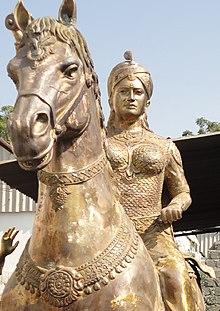Kakatiya dynasty
[6] Their territory comprised much of the present day Telangana and Andhra Pradesh, and parts of eastern Karnataka, northern Tamil Nadu, and southern Odisha.The demise of the Kakatiya dynasty resulted in confusion and anarchy under alien rulers for some time, before Musunuri Nayakas united the various Telugu clans and recovered Warangal from the Delhi Sultanate.However, Kumarasvami Somapithin, in his 15th-century commentary on Vidynatha's Prataparudra-Yashobhushanam or Prataparudriya states that the family was named after their tutelary goddess Kakati, a form of Durga.The 16th century Shitap Khan inscription mentions the reinstallation of the image of goddess Jaganmatruka (mother of the universe) and the lotus seat of the Kakatirajya, which had been destroyed by the Turushkas (Turkic people).[18] Ganapati-deva's Garavapadu charter traces the family's ancestry to Durjaya, a legendary chieftain of ancient Andhra, arrived at a town called Kakati during a hunting expedition, and set up his camp there.The probability is that many inscriptions have been lost due to buildings falling into disuse and also the ravages of subsequent rulers, most notably the Muslim Mughal Empire in the Telangana region.The most notable among these works include Prataparudriyam, Krida-bhiramamu, Panditaradhya-charitamu, Sivayogasaramu, Nitisara, Niti-sastra-muktavali, Nrutya-ratnavali, Pratapa-charita, Siddhesvara-charitra, Somadeva-rajiyamu, Palnativira-charitra, Velugotivari-vamsavali, and Velugotivari-vamsacharitra.[24] Besides epigraphs and literature, the forts, temples and tanks constructed during the Kakatiya period are an important source of information about contemporary society, art and architecture.[27] For example, the Motupalli inscription of Ganapati counts legendary solar dynasty kings such as Rama among the ancestors of Durjaya, the progenitor of the Kakatiya family.[31] The 956 CE Mangallu inscription was issued by the Vengi Chalukya prince Dānārnava, at the request of the Kakatiya chief Gunda IV.This theory is based on the fact that the phrase Rashtrakuta-kutumbinah appears in several Rashtrakuta-era copper-plate inscriptions, and refers to the officers and subjects of the Rashtrakuta kingdom.He notes that some chiefs of Rashtrakuta origin adopted the title "Viṭṭi-narayana", which means "as great as Narayana (Krishna) of the Vitti (Vrishni) family.[41] Sastry also believes that the early Kakatiya chiefs followed Jainism, which was also patronized by the Rashtrakutas, thus strengthening the view that the two dynasties were connected (see Religion section below).[39] The Bayyaram tank inscription calls the Kakatiya chief Beta I (son of Gunda IV) Garudamka-Beta, and "Garuda" here appears to refer to the family's emblem.The Rashtrakutas and some other dynasties of Deccan claimed descent from the Vrishni clan (associated with Vishnu's avatar Krishna) and had adopted Garuda as their royal insignia.[45] Krishna II captured the Kurravadi (possibly present-day Kuravi) region from the Vengi Chalukyas, and probably appointed Gunda III's son Erra as a governor there.[46] As a Rashtrakuta vassal, Betiya's son Gunda IV (r. c. 955-995) helped the Vengi Chalukya prince Danarnava ascend the throne after a succession dispute.[47] His son Beta I (r. c. 1000-1052 CE) accepted the Kalyani Chalukya suzerainty and received from them the fief of Anumakonda (modern Hanamakonda), which later became the Kakatiya capital.[61] A fragmentary Kannada language inscription also states that the Kakatiya general Bhairava defeated the Yadava army probably in or after 1263 CE, which may be a reference to his repulsion of Mahadeva's invasion.[67] Having no son as an heir,[61] Rudrama abdicated in favour of her grandson when it became apparent that the expansionist sultan Alauddin Khalji was encroaching on the Deccan and might in due course attack the Kakatiyas.[52][64] It is described by Eaton as the "first chapter in a larger story" that saw the style of polity in the Deccan change from being regional kingdoms to transregional sultanates that survived until the arrival of the British East India Company in the 18th century.[70] In 1311, Prataparudra formed a part of the sultanate forces that attacked the Pandyan empire in the south, and he took advantage of that situation to quell some of his vassals in Nellore who had seen his reduced status as an opportunity for independence.The succeeding Sultan Mubarak Shah responded by sending another of his Gujarati generals, Khusrau Khan,[76] to Orugallu with a force that bristled with technology previously unknown in the area, including trebuchet-like machines.Taking advantage of a revolution in Delhi that saw the Khalji dynasty removed and the Punjab-born Ghiyasuddin Tughlaq installed as sultan,[78] Prataparudra again asserted his independence in 1320.[h] The four dynasties were in a constant state of warfare with each other, with the Kakatiyas eventually exercising control from close to Anagondi in the west to Kalyani in the north-east, and down to Kanei and Ganjam district in southern Orissa.Even before the arrival of the dynasty, there were large, well-established and well-endowed Hindu places of worship in the relatively populous delta areas; however, the temples of the uplands, which were smaller and less cosmopolitan in origin and funding, did not exist until the Kakatiya period.The strengthening of those hierarchies, which was achieved in part by donating land for the temples and then attending worship, was necessary as the inland agrarian society grew rapidly in number and location.Colonial British administrators found much that appealed to them in the latter works but the Kakatiya inscriptions of Andhra Pradesh, which depict a far wider range of society and events, suggest that the reality was far more fluid and very different from the idealised image.[94] As early as 1330,[95] Musunuri Nayaks who served as army chiefs for Kakatiya kingdom united the various Telugu clans and recovered Warangal from the Delhi Sultanate and ruled for half a century.This work claimed, contrary to all reasonable evidence, that he did not die after being taken prisoner but instead met with the sultan, was recognised as being an avatar of Shiva, and was allowed to return to Orugallu.





WarangalTeluguSanskritKannadaHinduismJainismEastern ChalukyasWestern Chalukya EmpireReddi KingdomMusunuri NayakasDelhi SultanateBahmani SultanateVijayanagara EmpireAndhra PradeshTelanganaTelugu peopleGeographyPolitical historyAssakaSatavahanasAndhra IkshvakuAnanda GotrikaSalankayanasVishnukundinasPallava dynastyChola dynastyKota VamsaVelanati ChodasMusunuri NayaksRecherla NayaksPemmasani NayaksReddy dynastyGajapati EmpireSultanate of GolcondaHyderabad StateBritish RajTelugu dynastyDeccanKarnatakaTamil NaduOdishaRashtrakutasWestern ChalukyasGanapati DevaGodavariKrishnaRudrama DeviMarco PoloYadavasAlauddin KhaljitributeUlugh KhanTelugu languagenayakaThousand Pillar TempleHanamkondaRamappa TempleWarangal FortGolconda FortKota GulluGhanpurDineshchandra SircarShitap KhanTurushkasPadmavatiBayyaramDurjayachieftainKankerChhattisgarhKandharMaharashtraMughal EmpireP.V.P. SastryPrataparudraMotupalliPrakasam districtFirishtaKampili kingdomShudraNatavadiKshatriyaBrahmansImperial Cholassolar dynastyRashtrakutaVengi ChalukyaGunda IVGunda IIIsamantasKazipetDurgarajaBeta IISamantaVrishniGarudaPalampetRecharla RudravahanaVishnuavataryakshatirthankaraShantinathaChalukyas of KalyanivarahaKarikala CholaTelugu ChodasKashyapaParashuramaDasharatha-RamaBalaramaKrishna IIKuraviKalyani ChalukyasBeta ISomeshvara IProla IVemulavadaSouth Asia1175 CEKARAKHANIDKHANATEQARA KHITAIGHURIDEMPIREKUMAONCHAULUKYASCHAHAMANAS